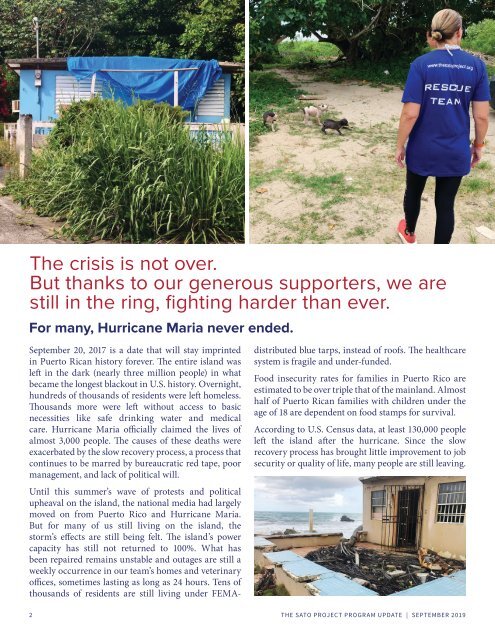The Sato Project 2019 Program Report
Two years have passed since Hurricane Maria devastated the island of Puerto Rico. The Sato Project is working to address the crisis of abandoned and suffering animals on the island through rescue and community outreach programs. This report highlights our impact on the island over the past year, as well as stories of some of the animals and people we have helped.
Two years have passed since Hurricane Maria devastated the island of Puerto Rico. The Sato Project is working to address the crisis of abandoned and suffering animals on the island through rescue and community outreach programs. This report highlights our impact on the island over the past year, as well as stories of some of the animals and people we have helped.
Create successful ePaper yourself
Turn your PDF publications into a flip-book with our unique Google optimized e-Paper software.
<strong>The</strong> crisis is not over.<br />
But thanks to our generous supporters, we are<br />
still in the ring, fighting harder than ever.<br />
For many, Hurricane Maria never ended.<br />
September 20, 2017 is a date that will stay imprinted<br />
in Puerto Rican history forever. <strong>The</strong> entire island was<br />
left in the dark (nearly three million people) in what<br />
became the longest blackout in U.S. history. Overnight,<br />
hundreds of thousands of residents were left homeless.<br />
Thousands more were left without access to basic<br />
necessities like safe drinking water and medical<br />
care. Hurricane Maria officially claimed the lives of<br />
almost 3,000 people. <strong>The</strong> causes of these deaths were<br />
exacerbated by the slow recovery process, a process that<br />
continues to be marred by bureaucratic red tape, poor<br />
management, and lack of political will.<br />
Until this summer’s wave of protests and political<br />
upheaval on the island, the national media had largely<br />
moved on from Puerto Rico and Hurricane Maria.<br />
But for many of us still living on the island, the<br />
storm’s effects are still being felt. <strong>The</strong> island’s power<br />
capacity has still not returned to 100%. What has<br />
been repaired remains unstable and outages are still a<br />
weekly occurrence in our team’s homes and veterinary<br />
offices, sometimes lasting as long as 24 hours. Tens of<br />
thousands of residents are still living under FEMA-<br />
distributed blue tarps, instead of roofs. <strong>The</strong> healthcare<br />
system is fragile and under-funded.<br />
Food insecurity rates for families in Puerto Rico are<br />
estimated to be over triple that of the mainland. Almost<br />
half of Puerto Rican families with children under the<br />
age of 18 are dependent on food stamps for survival.<br />
According to U.S. Census data, at least 130,000 people<br />
left the island after the hurricane. Since the slow<br />
recovery process has brought little improvement to job<br />
security or quality of life, many people are still leaving.<br />
2<br />
THE SATO PROJECT PROGRAM UPDATE | SEPTEMBER <strong>2019</strong>





